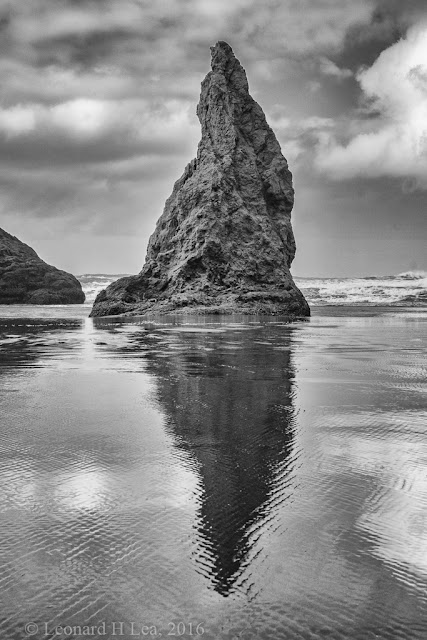It is easy to become "stuck" with any artistic endeavour and I find my photography is occasionally in need of some inspiring event to kick it into gear. Photography workshops help a great deal. Workshops mean that you often spend several days just taking photographs in the company of other like-minded people with little or no distractions. Add to this the fact that the workshop leaders have mapped out locations with the promise of interesting images, and they are on hand to make suggestions, both artistic and technical.
Recently I attended such a workshop which focused on a section of the Oregon coast around the town of Bandon.
The workshop was provided by: Northwest Photography Workshops, and led by David Cobb and Kevin McNeal, both very experienced photographers with international reputations.
This was a weekend workshop, beginning on Friday evening and ending on Monday morning.
The Friday evening is set up to introduce the participants and to map out the itinerary for the weekend. Since this was a winter workshop on the Oregon coast, we had to be prepared for potentially stormy and wet weather. We were very lucky, the rain and wind stayed away until Monday!
This portion of the Oregon coast is fortunate to have many lighthouses, so we made an early start to visit the Cape Blanco lighthouse, oldest standing lighthouse in Oregon.
We arrived before sunrise and found the light was still operating, and there was a little mist to enhance the light beam. We took many more photographs, but were unlucky as clouds obscured any potential for sunrise images.
Back for breakfast, followed by critiques and a presentation on some aspects of using image processing software.
The beach at Bandon has a large number of sea stacks that make for interesting challenges in image composition. The weather was kind to us with variable clouds and no rain.
This stack is one of several that have earned the name "wizard's hat"
This gives some idea of the rock formations along the beach.
There is a tendency, when faced with these glorious vista's, to miss looking "down"!
One of many small details on any beach when you stop a while.
On this visit I did not find any tide pools to explore, I probably just walked by them all. We did come across this lone purple sea-star. These creatures suffered a dramatic die off in 2014 from a sea-star wasting disease. I believe there are now some signs of recovery and evidence of other varieties taking their place.
We all setup for some sunset shots and hoped that we would see an actual sunset, as often an offshore fog bank will obscure the event. We were lucky, no fog bank and a few nice clouds.
After dinner we set up on the beach again to try some night photography. The idea was to get some good star images with the rocks in the foreground lit by light from houses and hotels on the cliffs behind us. Good news, the sky was fairly clear, the bad news (for night photography), we were two days before the full moon. Consequently, we had a lot more light than we had planned on. In spite of this, I am happy with these images, and if you look closely, there are stars!
The tide was coming in quite quickly, causing a high probability of wet feet. The water in this image comes very close, and running backwards with a tripod and camera is a new-found skill.
Another morning , another lighthouse, and a very brief sunrise. This is the Coquille River lighthouse, commissioned in 1896, decommissioned in 1936. Restored in 1976 and used as an interpretative center.
Not sure of the collective noun for a group of photographer's. Oh, it's a "clique" or "snap".
A framed view using some of the beach driftwood.
Later that day we hiked to this beach. It was 2 1/2 miles along a path with a significant number of water pools blocking the way. It was well worth the walk, which took us to this impressive range of cliffs that caught some of the setting sun.
The return along the same path took us through a coastal forest with a number of interesting mushrooms, if you looked closely. This was one of the prettier ones.
The walk back to the cars was now in the dark , which made navigating the pools of water along the path a bit more of an adventure, personal headlights were helpful.
The good news of having digital cameras means one is not limited to just a few shots. It does mean that you have a lot more to sort through. Thank goodness for dark winter days.













